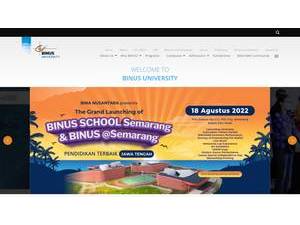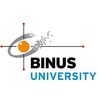
Overview
Established in 1996, the Universitas Bina Nusantara (Bina Nusantara University) is a non-profit private higher education institution located in the urban setting of the large metropolis of Jakarta (population range of over 5,000,000 inhabitants), Jakarta SCR. This institution also has branch campuses in Banten, Bandung, Semarang and Malang. Officially recognized by the Kementerian Pendidikan, Kebudayaan, Riset, dan Teknologi, Republik Indonesia (Ministry of Education, Culture, Research and Technology, Republic of Indonesia), Universitas Bina Nusantara (BINUS) is a very large sized (uniRank enrollment range: 30,000-34,999 students) coeducational Indonesian higher education institution. Universitas Bina Nusantara (BINUS) offers courses and programs leading to officially recognized higher education degrees such as bachelor's degrees, master's degrees and doctorate degrees in several areas of study. See the uniRank degree levels and areas of study table below for further details. This 28-year-old Indonesian higher-education institution has a selective admission policy based on entrance examinations. The acceptance rate range is 50-59% making this Indonesian higher education organization an averagely selective institution. International applicants are eligible to apply for enrollment. BINUS also provides several academic and non-academic facilities and services to students including a library, housing, sports facilities, financial aids and/or scholarships, study abroad and exchange programs, online courses and distance learning opportunities, as well as administrative services.
University Snapshot
Control
![]() private
private
Entity
![]() non-profit
non-profit
Size
![]() very large sized
very large sized
Selectivity
![]() averagely selective
averagely selective
University Identity
| Name | Universitas Bina Nusantara |
|---|---|
| Name (English) | Bina Nusantara University |
| Name (Non Latin) | |
| Acronym | BINUS |
| Founded | 1996 Origins date back to 1981 |
| Motto | Establishing the future through science and technology |
| Colours | Blue |
| Mascot | Bee |
| Screenshot |  |
| Video Presentation |
University Location
| Address | Jalan KH Syahdan No. 9, Palmerah Jakarta 11480 Jakarta SCR Indonesia |
|---|---|
| Location Map and Satellite View | |
| (21) 534 5830 | |
| (21) 530 0244 | |
| Other locations | Banten, Bandung, Semarang and Malang |





Social Media
Introduction
Social media can be a powerful tool for Universities to communicate with current students, alumni, faculty, staff and the wider community. But how can social media be important for prospective students? Read our article about the importance of Social Media for universities and prospective students to learn more.
Social Media
uniRank publishes brief reviews, rankings and metrics for some of Universitas Bina Nusantara's social media channels as a starting point for comparison and as an additional selection tool for potential applicants.
Universitas Bina Nusantara's Facebook page review
Universitas Bina Nusantara's X page review
Universitas Bina Nusantara's Youtube page review
Universitas Bina Nusantara's Instagram page review
Universitas Bina Nusantara's official LinkedIn profile
n.a.